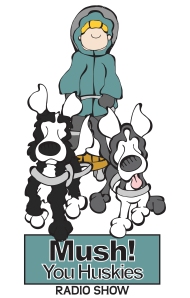The Future Home of Iditarod Dreams: Mush! You Huskies Radio Show
 As promised, yesterday, I wanted to showcase the sister show to our highly popular, Dog Doctor Radio Show to my rabid reader, fans and friends– Mush! You Huskies, better yet, MushingRadio.com was brought on board on the Dog Works Radio platform to fill a need for the future followers of Team Ineka and my quest to train for, and run the Iditarod in 2013.
As promised, yesterday, I wanted to showcase the sister show to our highly popular, Dog Doctor Radio Show to my rabid reader, fans and friends– Mush! You Huskies, better yet, MushingRadio.com was brought on board on the Dog Works Radio platform to fill a need for the future followers of Team Ineka and my quest to train for, and run the Iditarod in 2013.
We started the show to coincide with the start of the 2010 Iditarod in March and we followed the progress of the mushers on the trail and gave daily insight and commentary about the race. Not being a sportscaster, our shows had more of a statistical bent to it but hey, we will get better in the future, right?
This summer, we started our very popular Dog Sledding Legends series and did shows profiling the greats such as Leonhard Seppala, Scotty Allan, Doc Lombard, to name a few.
Our goal is to chronicle the adventures of my training and racing career though the show. I plan in the future of offering interviews of me (by my co-host, wife and business partner, Michele Forto). I hope to have other musher’s interviews as well.
I would also like to showcase our sponsors on the show and allow them the opportunity to take advantage of this unique advertising medium. As any musher knows, in order to get to the “big race” we have to run miles, miles and more miles, and we are often dependent on our generous sponsors in helping us reach our financial goals.
By continuing to use the BlogTalkRadio format we are able to bring the cutting edge technology of the platform and have the ability of adding video, chats, remote interviews, email, call-ins for our guests and of course an international audience. With this perfect marriage of technology and social media it is our hope to bring the sport of mushing and one man’s quest to make his own personal history a reality.
As we always say… Never Forget Your Dreams and we will see you on the trail!
I welcome your comments and suggestions. Please comment below.
Robert Forto | Team Ineka | Alaska Dog Works | Mushing Radio | Dog Doctor Radio | Denver Dog Works
___________________
Dr. Robert Forto is a musher training for his first Iditarod under the Team Ineka banner and the host of the popular radio shows, Mush! You Huskies and The Dog Doctor Radio Show